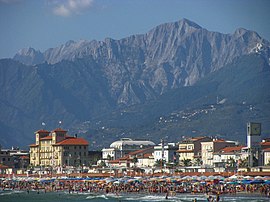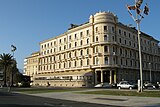Viareggio
| Viareggio | ||
|---|---|---|

|
|
|
| Country | Italy | |
| region | Tuscany | |
| province | Lucca (LU) | |
| Coordinates | 43 ° 52 ' N , 10 ° 15' E | |
| height | 2 m slm | |
| surface | 31.88 km² | |
| Residents | 61,989 (Dec. 31, 2019) | |
| Population density | 1,944 inhabitants / km² | |
| Post Code | 55049 (Viareggio), 55048 (Torre del Lago Puccini) | |
| prefix | 0584 | |
| ISTAT number | 046033 | |
| Popular name | Viareggini, Torrelaghesi | |
| Patron saint | Maria Santissima Annunziata (March 25) | |
| Website | Viareggio | |
 View of Viareggio |
||
Viareggio is a town with 61,989 inhabitants (as of December 31, 2019) in the northwest of the Italian region Tuscany in the province of Lucca .
The seaside resort on the Ligurian Sea is the location of marble processing , pottery and shipbuilding.
geography
Viareggio is located in the Ligurian coastal landscape of Versilia in front of the mountain range of the Apuan Alps . The area was a marshland around the coastal lake Lago di Massaciuccoli until the 18th century . With the drainage, the area gained in importance. One of the longest sandy beaches in Italy is located on the coast.
- City structure
Viareggio is divided into two Frazioni (districts): the actual city of Viareggio and the town of Torre del Lago Puccini to the south. There is also the subdivision into four urban districts (Circoscrizioni):
- Torre del Lago Puccini
- Centro - Marco Polo
- Darsena - Ex Campo d'Aviazione
- Viareggio Nuova
- Neighboring communities
The neighboring municipalities are Camaiore , Massarosa , both belonging to the province of Lucca, and Vecchiano in the province of Pisa .
history
Viareggio grew out of a fort that the cities of Lucca and Genoa built on the coast in 1172 to defend the area against Pisa . This fort was named Castrum de Via Regia , named after the royal road of the ruling Roman emperor Friedrich Barbarossa , which ran along the coast here. At the fortress the Canale Burlamacca flows into the sea, which was Lucca's only access to the sea from 1441, which increased the importance of the place and led to the construction of a small settlement. However, the surrounding swamp and with it the widespread malaria prevented the village from growing rapidly. As early as 1480, the city of Lucca offered free building land in the area around the fortress.
In 1543 another fortification, the Torre Matilde, was built, which guaranteed better military protection and led to increased settlement. The first church was built in 1559, in 1617 Viareggio became the vicariate seat for the settlements on the surrounding hills and finally in 1701 it was granted the right of a comunità , i.e. local self-government, by the Republic of Lucca. However, the main obstacle to development continued to be the surrounding swamp, so major drainage efforts were made in the 18th century, with the completion of which in 1741 malaria slowly began to decline.
To protect against the winds coming from the sea, pine forests were planted along the beach, which today characterize the cityscape. The southern section now forms part of the Migliarino, San Rossore, Massaciuccoli Regional Park .
Viareggio also shared the fate of Lucca historically: in 1799 Napoleon Bonaparte converted Lucca into a principality under his sister Elisa ; the Congress of Vienna created a Duchy of Lucca in 1815 under Maria Luise von Bourbon-Parma . It gave Viareggio town charter in 1820. In 1847 Viareggio came to the Grand Duchy of Tuscany and finally merged with it in a united Italy.
Viareggio's rise as a seaside resort began in the 19th century. In 1822 Napoleon's sister Paolina Borghese had a villa built (Villa Paolina) in which she spent the last years of her life. From 1828 onwards, various bathing establishments by the sea were gradually built (initially separated by gender). Numerous summer villas followed Paolina's example. Already at the beginning of the 19th century Viareggio was a pearl of the Tyrrhenian Sea and an internationally known seaside resort.
After the war, the city - like many places on the Italian Riviera - largely lost its exclusivity. Today Viareggio is primarily a holiday destination for the Italian population.
Late in the evening of June 29, 2009 occurred in the railway station a heavy Viareggio train crash , lost their lives in the 32 man. A train carrying butane gas derailed, gas escaped and exploded. This led to a major fire, several houses collapsed and about 100 people were left homeless.
politics
Marco Marcucci ( PD) was elected mayor in May 2003. Giorgio Del Ghingaro has been mayor since June 15, 2015. His Lista Civica has the majority in the municipal council with nine out of 24 seats.
Attractions
Art Nouveau building Duilio 48
-
Musei civici: The Musei civici are located in Villa Paolina, the former summer villa of Paolina Borghese and contain three collections:
- Museo Archeologico “Alberto Carlo Blanc”: Archaeological museum
- Pinacoteca "Lorenzo Viani": Pinacoteca of contemporary art
- Museo degli strumenti musicali "Giovanni Ciuffreda": Musical instrument museum
- Villa Museo Puccini: Puccini's former home is now a memorial and museum
- Museo del Carnevale: Carnival museum , founded in 2003
- Torre del Lago Puccini
The area of Torre del Lago , about 4 km from the coast, was hardly populated until the middle of the 18th century. As the swamps were drained, hunters, fishermen and farmers began to cultivate the area. The name comes from a watchtower that has stood on Lake Massaciuccoli since the 15th century. Giacomo Puccini was enthusiastic about the nature around the lake and rented two rooms in a villa in 1891. After the success of his " Tosca " he bought the villa and lived here until his death in 1924. After his death, the building was converted into a memorial.
Culture
- Teatro Politeama: The theater was founded in 1869 under the name Alhambra . It has had its current name since the new building in 1902. After being destroyed in the war, it was rebuilt in its current form in 1947 with 889 seats. Both musical theater guest performances and drama performances take place here in a winter season, since 1995 also in cooperation with the theater of the nearby Pietrasanta . It also serves as a cinema.
- Teatro Jenco: The municipal theater with 352 seats was inaugurated in 2003. The season with guest performances - especially of entertainment theater - lasts from February to April.
- Dialect theater performances are held several times a year in both theaters.
Regular events
- Festival Puccini
Festival Puccini , an opera festival that every summer performs operas by the composer on an open-air stage on the shores of Lago Puccini.
- carnival
A major tourist attraction is the Carnival , which has been celebrated in Viareggio since 1873. On five weekends, a large carnival procession with triumphal floats made of paper mache moves through the city. The local carnival mask is the Burlamacco .
In 2001 the carnival "Citadel" was built for the wagon construction workshops and a paper mache school, which houses the carnival museum and event rooms.
- Premio Viareggio
The Premio Viareggio is one of the oldest literary prizes in Italy; it has been awarded annually in Viareggio since 1929.
- EuropaCinema
The film festival, originally founded in Rimini in 1984 , has been held annually in Viareggio since 1989. It is dedicated to European film, with a focus country that changes every year.
- Soccer tournament
The Torneo di Viareggio football tournament has been held annually since 1948 and is one of the most important competitions for youth teams worldwide. Big players like Gabriel Batistuta , Alessandro Del Piero or Francesco Totti drew attention here for the first time.
Sports
On February 23, 1968, the first international match of the Italian women's national football team took place in Viareggio .
Town twinning
|
|
Personalities
- Daughters and sons of the city
- Inigo Campioni (1878–1944), admiral and senator
- Alberto Bertuccelli (1924–2002), football player
- Nora Ricci (1924–1976), film actress
- Alberto Tenenti (1924–2002), historian
- Eugenio Fascetti (* 1938), football player and coach
- Stefania Sandrelli (born 1946), film actress
- Marcello Lippi (* 1948), football coach
- Battista Lena (* 1960), jazz musician and film composer
- Nicola Luisotti (* 1961), conductor
- Giampaolo Simi (* 1965), writer and journalist
- Carlo Andrea Magnani, stage name Olaf Thorsen (* 1971), metal guitarist
- Davide Sanguinetti (* 1972), tennis player
- Andrea Masiello (* 1986), football player
- Matteo Gentili (* 1989), football player

- Personalities with a relationship to the city
- Pauline Bonaparte (1780–1825), called Paolina Borghese in Italy , sister of Napoléon Bonaparte
- Giovanni Pacini (1796–1867), opera composer, lived in Viareggio from around 1822
- Maria Louise [de la] Ramée, pseudonym Ouida (1839–1908), British writer, died in Viareggio
- Giacomo Puccini (1858–1924), Italian opera composer
- Salome Kruschelnytska (1872–1952), Ukrainian opera singer and wife of the two-time mayor of Viareggio, Marquis Cesare Riccione († 1938)
- Rainer Maria Rilke (1875–1926), Austrian poet, wrote the third part of his book of hours in Viareggio in 1903 ( The Book of Poverty and Death )
- Marino Marini (1901–1980), Italian sculptor and graphic artist, died in Viareggio
- Elke Sommer (* 1940) was surprisingly elected Miss of the Town in a café in Viareggio while she was on vacation with her mother in Italy in 1958. Because of the subsequently published photos of Miss Viareggio, which caused a sensation, the Italian film producer Vittorio de Sica brought her to Rome, which began her career.
Web links
Individual evidence
- ↑ Statistiche demografiche ISTAT. Monthly population statistics of the Istituto Nazionale di Statistica , as of December 31 of 2019.
- ↑ European Railway Agency












